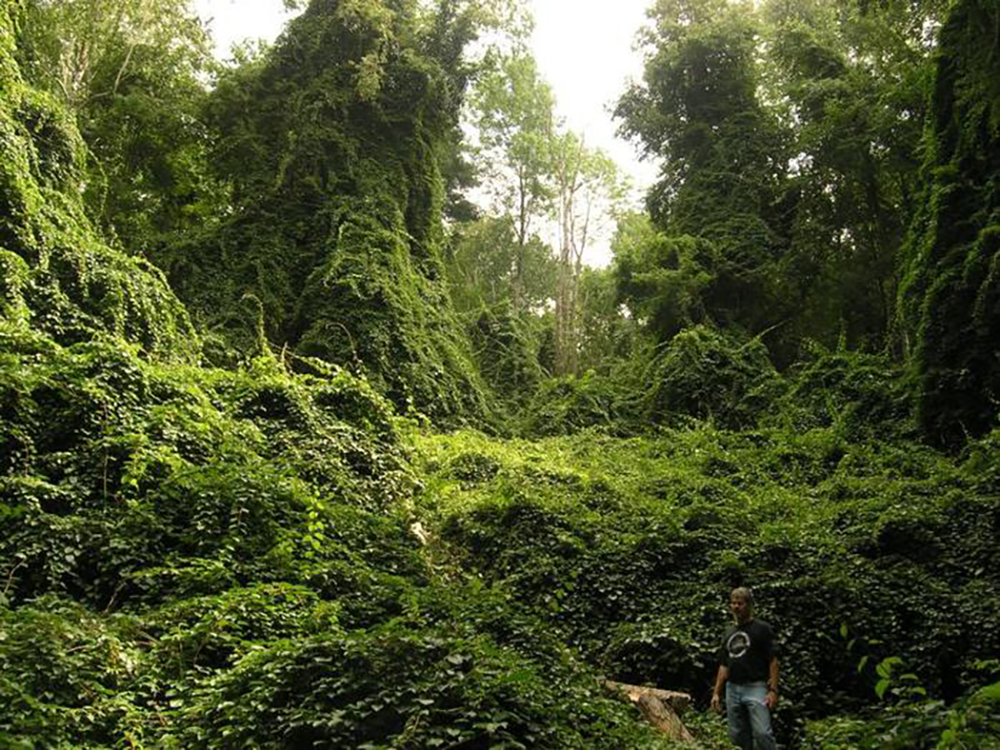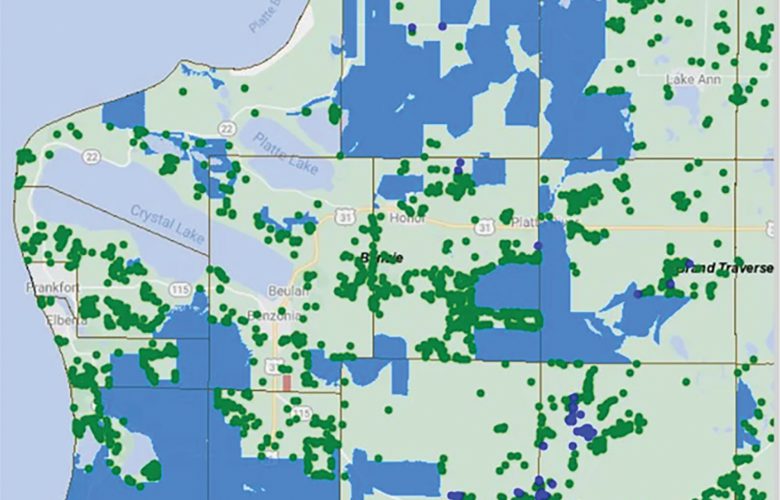Invasive species are on the move
By Emily Cook
Current Contributor
The most recent global assessment of plants revealed there to be an estimated 391,000 different species. In North America alone, the census lowers to 17,000—still a staggering number, which does not even account for plant-like organisms like algae, mosses, and lichens.
If you were to wander down a wooded hiking trail in Northern Michigan and scan the landscape from the very top of the tree canopy down to the forest floor, it would not be unusual for your eyes to land on dozens of different species—perhaps the arms of an old-growth beech tree tower over you, while the blossoms of heart-leaved asters hit your knees as you walk by. This incredible diversity, provided by plants, serves as a critical part of the foundation for all living things.
Sometimes, however, a landscape contains plant species that should not be there. These non-native species are introduced—either intentionally or accidentally—and, if they begin to take over, they are known as “invasive” species, because that is exactly what they do. They grow faster and larger than many natives and are typically more resilient or undesirable to predation, such as browsing deer. Gradually, the diversity of a region begins to lower.
Plant & Animal Invasives Regionally
Continuing by the numbers, there are nearly 150 invasive species that are already having an impact or could potentially have an impact on our corner of the state.
The Northwest Michigan Invasive Species Network (ISN) has consolidated that into a list that is manageable when it comes to hands-on treatment and educating the public on how to help with this conservation issue. Many of the names are recognizable: garlic mustard (Alliaria petiolata), phragmites (Phragmites australis), honeysuckle (Lonicera morrowii), callery pear (Pyrus calleryana), Japanese barberry (Berberis thunbergii), and baby’s breath (Gypsophila paniculata). [Editor’s Note: Check out previous articles, written on many from this list, in The Betsie Current’s online archives.]
Others are less common but still on ISN’s radar: black swallow-wort (Cynanchum louiseae), Japanese chaff flower (Achyranthes japonica), kudzu (Pueraria montana), giant hogweed (Heracleum mantegazzianum), and coltsfoot (Tussilago farfara) are a few examples.
For a plant to become truly invasive, a perfect cocktail of conditions is necessary.
The species must be from another part of the world and cause harm to human health, the environment, and/or the economy. Additionally, site conditions need to be ideal—although many invasives thrive in less-than-perfect soils and lighting—and there needs to be a way the plant gets moved. Sometimes this happens simply, through birds. Other times, it can be a result of planting an invasive species in your garden and having it spread into a nearby natural area. (More than 90 percent of the top species targeted by ISN were introduced intentionally as “ornamentals.” )
Taking all that information into account, while many of us would like to label poison ivy (Toxicodendron radicans) as an invasive species, it is not. Rather, it is a native plant that can harm people but, generally, has very little negative impact on the surrounding ecosystem.
What Is Next?
As our climate continues to change and growing boundaries expand northward, land managers are constantly keeping track of “the next thing.”
At times, a changing climate is not even required for a new species to be introduced from another part of Michigan or a state to the south, like Ohio or Indiana. Plant seeds—and other invasive species, like insects—will readily hitch a ride on our shoes, vehicles, and other recreation equipment as we travel to new places. For instance, quagga mussels (Dreissena bugensis) got into the Great Lakes by attaching to boats, and the emerald ash borer (Agrilus planipennis) came to Michigan by being inside wood that was moved from another part of the country.
A few invasive species that ISN has more recently shifted focus to—both plant and animal—are outlined here: keep an eye out for them as you explore the northwest Lower Peninsula of Michigan. Spotting them early can make all the difference when it comes to successful management.

Hardy kiwi (Actinidia arguta): Also known as kiwiberry, this species is closely related to the plants that produce the fuzzy, brown kiwifruit that you can purchase at the grocery store. Hardy kiwi, however, produces small, smooth-skinned fruit that are each not much larger than a grape.
As their original branding of “Chinese gooseberries” suggests, fuzzy kiwis are native to China and will not tolerate cold temperatures, whereas hardy kiwis are native to Japan, Northern China, and the Russian Far East, so they are much more cold-tolerant—thus hardy.
Like its more common relative, the hardy fruits are completely edible and are starting to be grown more often by U.S. farmers who need to fill in the seasonal gaps when production is lower. In our region, the fruits typically ripen in mid-summer and extend through the early fall months, placing it firmly between cherry and apple season.
Like many invasive species, hardy kiwi was introduced as an ornamental in the 19th century. Unfortunately, it escaped cultivation, and on the East Coast of the United States, specifically Massachusetts, populations began to spread into nearby natural areas. Large swaths of forest have the kiwi plants climbing—and subsequently choking out—large, native trees.
While its invasiveness is still being questioned and studied elsewhere, hardy kiwi is a species being carefully watched, as it has the potential to become introduced and spread in Northern Michigan.
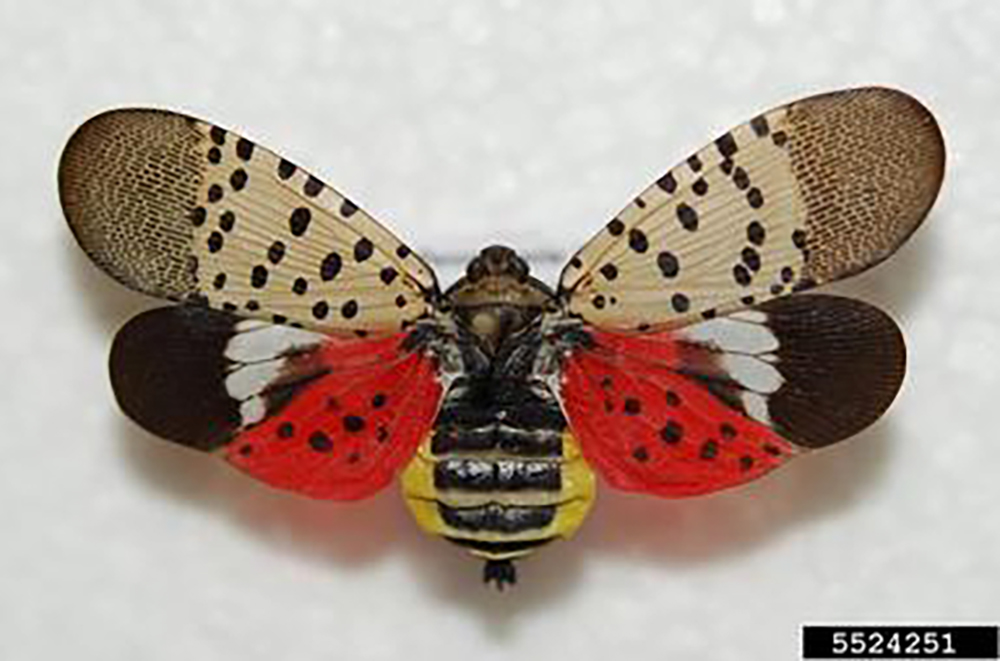
Spotted lanternfly (Lycorma delicatula): Despite having a focus on primarily terrestrial plants, ISN does work across other aspects of the invasive species world, and thus the organization is always looking out for things like spotted lanternfly, originally from China, India, and Vietnam. This insect was first detected in 2014 in nearby Pennsylvania and has a close relationship with another invasive species that is already prevalent in our region, the tree-of-heaven (Ailanthus altissima), also originally from China—it was brought to the United States in the late 1700s as a fast-growing ornamental shade tree.
Tree-of-heaven is a preferred host plant for spotted lanternflies to lay their eggs; because of this existing relationship, it is concerning that the lanternfly could become easily established here.
Spotted lanternfly has the potential to be very damaging if it becomes established. It prefers plants that typically have a higher economic value—like fruit trees, black walnuts, maples, and willows—however, the insect has been known to target about 70 different species. Their feeding stresses the plants, which can lead to a significant decrease in arboreal health and, often, death.
So far, the good news is that no live lanternflies have been identified in Michigan. Some dead insects were found in some shipping material downstate, an event which served as a great reminder to remain diligent and to check for invasive hitchhikers!
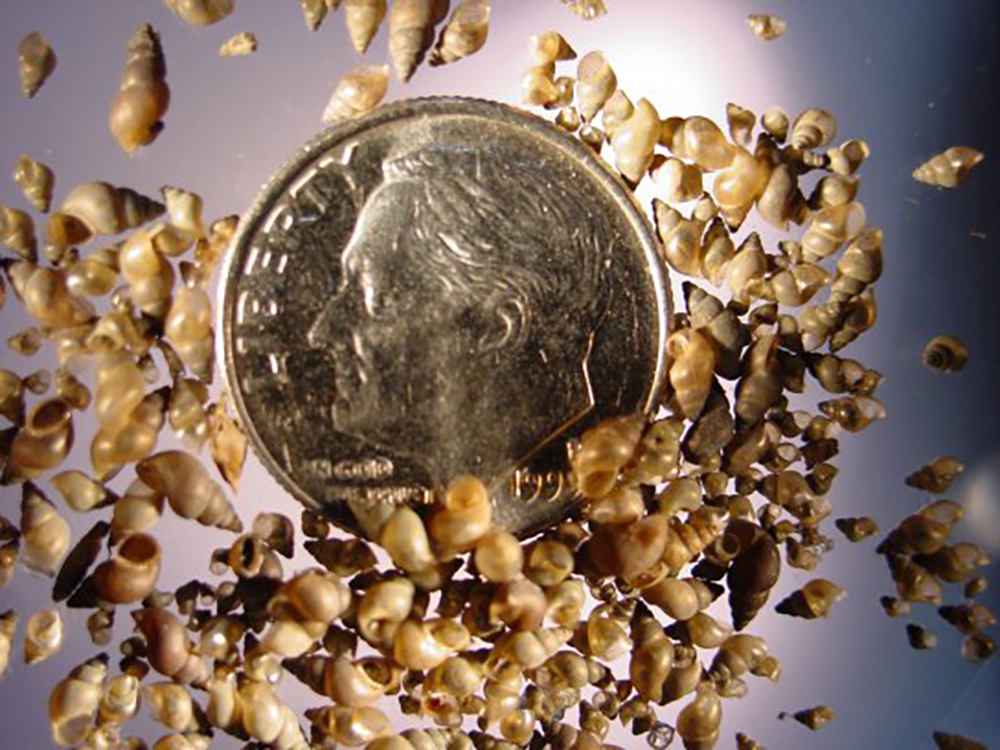
New Zealand mudsnail (Potamopyrgus antipodarum): These aquatic snails, which have already been identified in water bodies throughout northwest Michigan, thrive in a variety of conditions and tolerate varying temperatures and water velocities. Most likely introduced through contaminated ballast water discharge from boats, these snails are tiny—only about one-eighth of an inch long as adults.
New Zealand mudsnails reproduce entirely by females that self-clone, and each female has the potential to produce a colony of 40 million snails in a single year. Because of how quickly they reproduce and how much they consume in water bodies, they can easily outcompete the native snails, insects, and other aquatic life that fish rely on for food; from there, the entire food chain can become disrupted.
As you recreate in Northern Michigan’s waters this summer, make sure that you are not transporting this invasive to a new location. The snails easily attach to waders, boats, nets, fishing gear, etc. and with the ability to seal their shell, they can survive outside of water for up to two weeks. Simply moving your canoe from the Betsie River to the Platte River, for example, could mean the introduction of a new population of an invasive species, so taking a few moments to check your gear is critical!
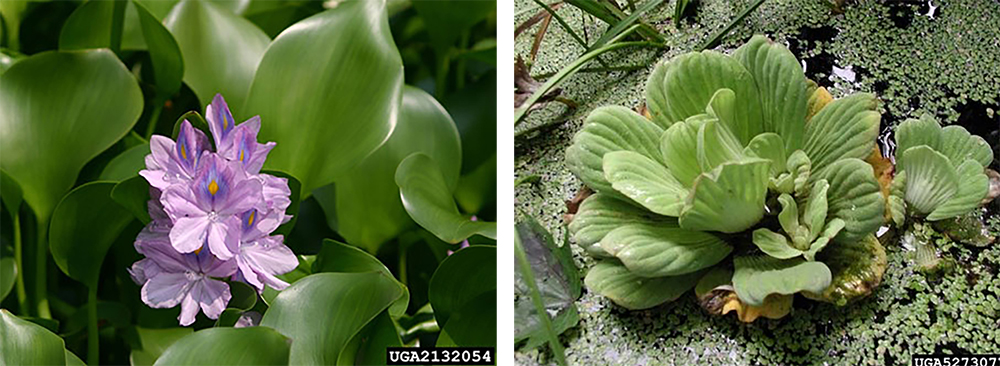
Water hyacinth (Eichhornia crassipes) / Water lettuce (Pistia stratiotes): These two plants are being combined, because they are both “watch list” species in Michigan that are currently still allowed for sale. So far, our winters are too cold to allow for over-wintering, and no signs have been found that they have escaped cultivation. However, with a milder climate, the concern of this changing is prevalent.
Both water hyacinth and water lettuce are free-floating plants that have the potential to form dense colonies on the surface of water bodies. This prevents sunlight from reaching native species. On a human level, the dense mats can also prevent boat movement and reduce water flow.
Water hyacinth—native to subtropical and tropical South America, particularly the Amazon basin—is one of the fastest-growing plants known, and each plant can annually produce thousands of seeds, which can remain viable for almost three decades. The plants may rise as much as three feet in height above the water surface, and mats can double in size in just a couple of weeks. Notably, it was illegal to sell water hyacinth in the United States from 1956 until December 27, 2020, when the 116th Congress repealed the law.
The origins of water lettuce are disputed, though it is probably pantropical; now, water lettuce is present in nearly all tropical and subtropical fresh waterways, as it is among the world’s most productive freshwater aquatic plants. Where there is high nutrient content—such as places that have been contaminated with human loading of sewage and/or fertilizers—water lettuce can become overgrown; when this happens, it can block gas exchange at the water surface, which can reduce the amount of oxygen in the water and kill fish. Moreover, there are mosquitoes in the southeastern United States that reproduce only in the presence of aquatic plants like water lettuce.
The main thing that can be done to prevent the establishment of these two species is to not purchase them in the first place. If you do, keep a careful eye on the plants, and make sure they are not surviving our Michigan winters.
While this list is by no means representative of all species of concern, it is an excellent snapshot of what to look for while exploring Northern Michigan’s forests and waters this summer.
Emily Cook resides in Arcadia with her family; she has worked for the Invasive Species Network since 2015 and in the world of plant management and conservation since 2008.. If you think that you have spotted one of the above-listed invasive species—or another of the nearly 150 that are affecting Northern Michigan—ISN would like to know. Questions on emerging species and other invasive subjects can be directed to Emily Cook, ISN’s outreach specialist, by sending an email to ecook@gtcd.org. General invasive species information can be found at HabitatMatters.org.

